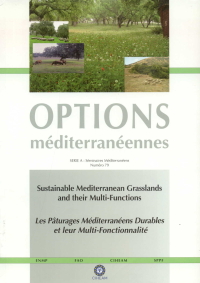| Article précédent | p. 207-210 | Article suivant |
Etude de comportement de trois graminées fourragères : Dactylis glomerata L., Festuca arundinacea Schreb., Phalaris aquatica Desf., en Algérie
Dans le cadre du projet PERMED et durant deux années, le suivi d'un essai de comportement en milieu méditerranéen a été réalisé sur plusieurs variétés de graminées fourragères appartenant à trois espèces. L'étude de la production fourragère, en première année, montre la supériorité du dactyle par rapport aux deux autres espèces; le dactyle Porto enregistra le meilleur rendement avec 19,13 t MV ha-1 et 5,33 t MS ha-1. En deuxième année, les fétuques donnent les meilleurs rendements avec des comportements saisonniers différents entre variétés. La fétuque Fletcha surclasse l'ensemble avec un rendement annuel de 32,24 t MV ha-1 et 10,44 t MS ha-1 et un rendement hivernal appréciable. Hormis le rendement printanier (11,85 à 17,30 t MV ha-1 et 3,77 t MS ha-1 à 5,04 t MS ha-1), les dactyles montrent des rendements faibles par rapport aux fétuques. Les rendements du phalaris sont proches de ceux de la fétuque en période printanière.
A study on the agronomical behaviour under a Mediterranean environment was carried out on several fodder grass varieties belonging to three species, within the PERMED project and over a period of two years. The study of characters related to forage production, in the first year, showed the superiority of cocksfoot compared to the other two species; Porto (cocksfoot) reported the best yield with 19.13 t FM/ha and 5.33 t DM/ha. In the second year, fescue varieties gave the best yields showing different seasonal behaviour depending on the variety. Fletcha (fescue) outclassed the whole with an annual yield of 32.24 t FM/ha and 10.44 t DM/ha, and an appreciable winter production. Except for the spring yields (11.85 to 17.30 t FM ha-1 and 3.77 t DM ha-1 to 5.04 t DM ha-1), cocksfoot varieties showed yields comparable to those of fescue. Phalaris yields are rather close to those of tall fescue in the spring period.
- [ Afficher ]
- [ Télécharger ]
- [ Exporter la citation ]
Vous pouvez télécharger la citation au format :
- [ Imprimer ]
-
Mots-clés
DACTYLIS GLOMERATA, EXPERIMENTATION, FESTUCA, GRAMINEE FOURRAGERE, PHALARIS, REGION MEDITERRANEENNE, RENDEMENTCiter cet article
Khedim A., Khelifi H.E., Nabi M., Hadj-Omar K., Mefti M., Maouche S., Bellague D., M'Hammedi Bouzina M., Laouar M., Merabet B.A., Bouzerzour H., Abdelguerfi A. Etude de comportement de trois graminées fourragères : Dactylis glomerata L., Festuca arundinacea Schreb., Phalaris aquatica Desf., en Algérie. In : Porqueddu C. (ed.), Tavares de Sousa M.M. (ed.). Sustainable Mediterranean grasslands and their multi-functions . Zaragoza : CIHEAM / FAO / ENMP / SPPF, 2008. p. 207-210. (Options Méditerranéennes : Série A. Séminaires Méditerranéens; n. 79). 12. Meeting of the Sub-Network on Mediterranean Forage Resources of the FAO-CIHEAM Inter-regional Cooperative Research and Development Network on Pastures and Fodder Crop, 2008/04/09-12, Elvas (Portugal). http://om.ciheam.org/om/pdf/a79/00800647.pdf



